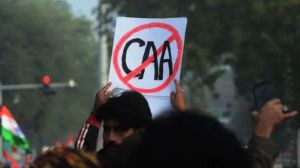How to hedge against a slowdown
Let's be clear at the outset-the Indian economy is not slipping into recession.

Let’s be clear at the outset — the Indian economy is not slipping into recession. Instead, after accelerating for three years since 2004-05 from 7.5 per cent to reach 9.4 per cent in 2006-07, the growth of the gross domestic product has slowed just a bit to 8.7 per cent this year. That still makes India the second fastest growing economy in the world. Not bad at all. Just seven years ago, in 2001-02, GDP grew at 5.8 per cent.
This kind of growth has never been achieved by India in the past but it is quite possible to sustain it into the future. Going into the new fiscal year, the factors that sustained this growth rate are still strong. These are high rates of domestic savings and investment, strong corporate performance and, based on those, a high tax mop-up which has turned around the finances of state and Central governments. The last is particularly important as this means the government does not have to dip into the citizen’s pockets as taxes to pay for its own existence.
In that case, why is the economy showing signs of a pause? Because, the government is unwilling to make some changes, that would give business the additional wind to push ahead.
This is the biggest downside risk that the Indian economy faces. Alan Greenspan, former governor of the US Federal Reserve, said at a recent seminar in New York that the only reason why the US economy was still not in recession was the muscle built up by US business in the long period of growth post-9/11. The implication is, without that muscle, the recession would have already been a full gale.
Looking at the Indian economy at an inflection point, it is clear that in the last few years business in some sectors has not built up those muscles. A big reason is government inaction. Describing the phenomenon, the economic advisory council of the prime minister says: “There are some downside risks that can stem from not being able to take much needed decisions.” Among them, it lists the reluctance to change prices in fuel sector and absence of a long-term fertiliser policy. Not changing the prices has not helped the people. In this fiscal the government has issued bonds as off-budget liability of over Rs 1,00,000 crore on these two counts. We will pay for them later as taxes, when the government redeems the bonds. Meanwhile, the oil marketing companies will bleed, since they are short of the cash they need to invest in improving their network. Since they cannot stretch their networks further, the queues for LPG cylinders in cities and for kerosene in villages have begun to lengthen.
The same holds true for fertilisers. The last time prices were revised for urea was in 2002. Since then, costs have multiplied and therefore supply has dwindled. Subsidised fertilisers have not pushed production of grains. Instead banning futures trade in commodity exchanges for all grains has taken away farmers’ ability to gauge the real price of their produce. The simultaneous curbs on the development of organised retail in foodgrains and vegetables have only reinforced the role of middlemen in the market, at the expense of farmers.
The other area of concern is, of course, power. In 2007-08, the economy has added record generation capacity but that is just nowhere near what is required to feed a 9 per cent GDP growth rate. So every industry is resorting to power back-up, which is very expensive, and drives up costs all round. The power tale is of course the biggest soap opera that has been on in the Indian economy for as long as anyone cares to remember.
But in a downturn, the plot can very quickly turn cruel. Acceleration in the growth rate, just like a speeding car, makes the discomfort of potholes fleeting. The bumps appear more acute and wearying when there is even a slight slowdown, like now. These bumps are the impact of the sharp spike in interest rates on auto loans and consumer durables. Consumers are disappearing from the show rooms. The impact on the industrial sector has been felt in the metals sector. The December IIP figures show the trend very clearly. Industrial activity has weakened very sharply in construction too. The only two sectors which have bucked the trend are basic chemicals and machinery plus equipment. The latter has been holding up, as spending on infrastructure has risen in some sectors.
So the growth rate in the industrial sector is now poised pretty delicately in some sectors. The industrial sector therefore needs the support of the government not for tax breaks but to think through the right combination of policies to make consumers return to their buying ways. The alternative of a pay commission to put some cash in the pockets of government employees would not work. The upshot is, the economy could log less than an 8 per cent rate of growth of GDP in 2008-09.
But of course that would immediately remove the need for the government to be apologetic about the accelerating growth rate. Much as the Indian cricket team plays well only under pressure, the environment of slowdown would give the government the justification to carry through changes in the policy regime to prepare businesses to take advantage of the next burst of a favourable wind.
The writer is resident editor, Delhi, ‘The Financial Express’ subhomoy.
bhattacharjee@expressindia.com



- 01
- 02
- 03
- 04
- 05




























